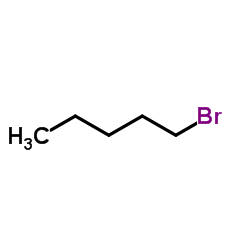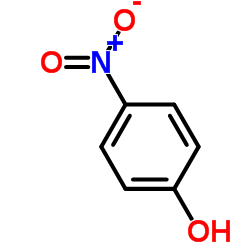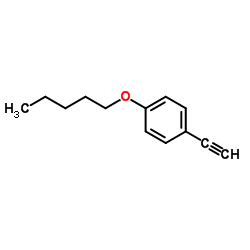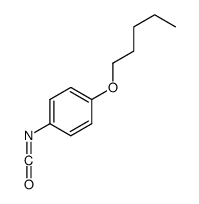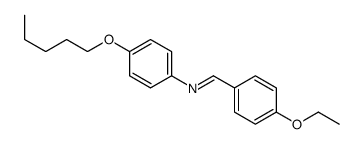39905-50-5
| 中文名 | 4-戊氧基苯胺 |
|---|---|
| 英文名 | 4-pentoxyaniline |
| 中文别名 | 对戊氧基苯胺 |
| 英文别名 |
4-pentyloxyphenylamine
4-n-pentoxyaniline 4-n-pentyloxyaniline 4-(Pentyloxy)anilin pentyloxyaniline Benzenamine, 4-(pentyloxy)- 4-pentoxyphenylamine 4-(Pentyloxy)aniline 4-Nonyloxyaminobenzene p-pentyloxyaniline |
| 密度 | 1.0±0.1 g/cm3 |
|---|---|
| 沸点 | 294.2±13.0 °C at 760 mmHg |
| 分子式 | C11H17NO |
| 分子量 | 179.259 |
| 闪点 | 130.7±13.1 °C |
| 精确质量 | 179.131012 |
| PSA | 35.25000 |
| LogP | 2.87 |
| 蒸汽压 | 0.0±0.6 mmHg at 25°C |
| 折射率 | 1.525 |
| 储存条件 | 密封、阴凉、干燥保存 |
| 稳定性 | 常规情况下不会分解,没有危险反应 |
| 计算化学 | 1.疏水参数计算参考值(XlogP):无 2.氢键供体数量:1 3.氢键受体数量:2 4.可旋转化学键数量:5 5.互变异构体数量:无 6.拓扑分子极性表面积35.2 7.重原子数量:13 8.表面电荷:0 9.复杂度:119 10.同位素原子数量:0 11.确定原子立构中心数量:0 12.不确定原子立构中心数量:0 13.确定化学键立构中心数量:0 14.不确定化学键立构中心数量:0 15.共价键单元数量:1 |
| 更多 | 1. 性状:未确定 2. 密度(g/mL,25 ºC):0.97g/mLat 25°C(lit.) 3. 相对蒸汽密度(g/mL,空气=1): 未确定 4. 熔点(ºC):未确定 5. 沸点(ºC):未确定 6. 沸点(ºC,40mm hg):未确定 7. 折射率:n20/D 1.532(lit.) 8. 闪点(ºC):>230°F 9. 比旋光度(º):未确定 10. 自燃点或引燃温度(ºC): 未确定 11. 蒸气压(kPa,25ºC):未确定 12. 饱和蒸气压(kPa,60ºC): 未确定 13. 燃烧热(KJ/mol):未确定 14. 临界温度(ºC):未确定 15. 临界压力(KPa):未确定 16. 油水(辛醇/水)分配系数的对数值:未确定 17. 爆炸上限(%,V/V):未确定 18. 爆炸下限(%,V/V):未确定 19. 溶解性:未确定 |
Synonym:Benzenamine, 4-(Pentyloxy)- Section 2 - COMPOSITION, INFORMATION ON INGREDIENTS
Risk Phrases: 20/21 Section 3 - HAZARDS IDENTIFICATION EMERGENCY OVERVIEW
Harmful by inhalation and in contact with skin.The toxicological properties of this material have not been fully investigated. Potential Health Effects Eye: May cause eye irritation. Skin: May cause skin irritation. Ingestion: May cause irritation of the digestive tract. May cause cardiac disturbances. May cause methemoglobinemia, cyanosis (bluish discoloration of skin due to deficient oxygenation of the blood), convulsions, and death. The toxicological properties of this substance have not been fully investigated. May cause central nervous system depression. Inhalation: May cause respiratory tract irritation. May cause methemoglobinemia, cyanosis (bluish discoloration of skin due to deficient oxygenation of the blood), convulsions, tachycardia, dyspnea (labored breathing), and death. The toxicological properties of this substance have not been fully investigated. May cause cardiac abnormalities. Inhalation at high concentrations may cause CNS depression and asphixiation. Chronic: No information found. Section 4 - FIRST AID MEASURES Eyes: Immediately flush eyes with plenty of water for at least 15 minutes, occasionally lifting the upper and lower eyelids. Get medical aid. Skin: Get medical aid. Flush skin with plenty of water for at least 15 minutes while removing contaminated clothing and shoes. Wash clothing before reuse. Ingestion: Never give anything by mouth to an unconscious person. Get medical aid. Do NOT induce vomiting. If conscious and alert, rinse mouth and drink 2-4 cupfuls of milk or water. Inhalation: Remove from exposure and move to fresh air immediately. If not breathing, give artificial respiration. If breathing is difficult, give oxygen. Get medical aid. Notes to Physician: Section 5 - FIRE FIGHTING MEASURES General Information: As in any fire, wear a self-contained breathing apparatus in pressure-demand, MSHA/NIOSH (approved or equivalent), and full protective gear. During a fire, irritating and highly toxic gases may be generated by thermal decomposition or combustion. Vapors may be heavier than air. They can spread along the ground and collect in low or confined areas. Containers may explode when heated. Combustible material; may burn but does not ignite readily. Runoff from fire control or dilution water may cause pollution. Extinguishing Media: Use water spray to cool fire-exposed containers. Do NOT get water inside containers. For small fires, use dry chemical, carbon dioxide, or water spray. For large fires, use dry chemical, carbon dioxide, alcohol-resistant foam, or water spray. Section 6 - ACCIDENTAL RELEASE MEASURES General Information: Use proper personal protective equipment as indicated in Section 8. Spills/Leaks: Absorb spill with inert material (e.g. vermiculite, sand or earth), then place in suitable container. Avoid runoff into storm sewers and ditches which lead to waterways. Clean up spills immediately, observing precautions in the Protective Equipment section. Provide ventilation. Section 7 - HANDLING and STORAGE Handling: Wash thoroughly after handling. Use with adequate ventilation. Avoid contact with eyes, skin, and clothing. Keep container tightly closed. Avoid ingestion and inhalation. Storage: Store in a tightly closed container. Store in a cool, dry, well-ventilated area away from incompatible substances. Section 8 - EXPOSURE CONTROLS, PERSONAL PROTECTION Engineering Controls: Facilities storing or utilizing this material should be equipped with an eyewash facility and a safety shower. Use adequate ventilation to keep airborne concentrations low. Exposure Limits CAS# 39905-50-5: Personal Protective Equipment Eyes: Wear appropriate protective eyeglasses or chemical safety goggles as described by OSHA's eye and face protection regulations in 29 CFR 1910.133 or European Standard EN166. Skin: Wear appropriate protective gloves to prevent skin exposure. Clothing: Wear appropriate protective clothing to prevent skin exposure. Respirators: Follow the OSHA respirator regulations found in 29 CFR 1910.134 or European Standard EN 149. Use a NIOSH/MSHA or European Standard EN 149 approved respirator if exposure limits are exceeded or if irritation or other symptoms are experienced. Section 9 - PHYSICAL AND CHEMICAL PROPERTIES Physical State: Liquid Color: gold Odor: Not available. pH: Not available. Vapor Pressure: Not available. Viscosity: Not available. Boiling Point: Not available. Freezing/Melting Point: Not available. Autoignition Temperature: Not applicable. Flash Point: 109 deg C ( 228.20 deg F) Explosion Limits, lower: Not available. Explosion Limits, upper: Not available. Decomposition Temperature: Solubility in water: Specific Gravity/Density: .9700g/cm3 Molecular Formula: C11H17NO Molecular Weight: 179.26 Section 10 - STABILITY AND REACTIVITY Chemical Stability: Stable at room temperature in closed containers under normal storage and handling conditions. Conditions to Avoid: Incompatible materials, excess heat, strong oxidants. Incompatibilities with Other Materials: Acids, acid chlorides, acid anhydrides, chloroformates, oxidizing agents. Hazardous Decomposition Products: Nitrogen oxides, carbon monoxide, irritating and toxic fumes and gases, carbon dioxide, nitrogen. Hazardous Polymerization: Has not been reported Section 11 - TOXICOLOGICAL INFORMATION RTECS#: CAS# 39905-50-5 unlisted. LD50/LC50: Not available. Carcinogenicity: 4-Pentyloxyaniline - Not listed by ACGIH, IARC, or NTP. Section 12 - ECOLOGICAL INFORMATION Section 13 - DISPOSAL CONSIDERATIONS Dispose of in a manner consistent with federal, state, and local regulations. Section 14 - TRANSPORT INFORMATION IATA Shipping Name: TOXIC LIQUID, ORGANIC, N.O.S.* Hazard Class: 6.1 UN Number: 2810 Packing Group: III IMO Shipping Name: TOXIC LIQUID, ORGANIC, N.O.S. Hazard Class: 6.1 UN Number: 2810 Packing Group: III RID/ADR Shipping Name: TOXIC LIQUID, ORGANIC, N.O.S. Hazard Class: 6.1 UN Number: 2810 Packing group: III Section 15 - REGULATORY INFORMATION European/International Regulations European Labeling in Accordance with EC Directives Hazard Symbols: XN Risk Phrases: R 20/21 Harmful by inhalation and in contact with skin. Safety Phrases: S 23 Do not inhale gas/fumes/vapour/spray. WGK (Water Danger/Protection) CAS# 39905-50-5: No information available. Canada CAS# 39905-50-5 is listed on Canada's NDSL List. CAS# 39905-50-5 is not listed on Canada's Ingredient Disclosure List. US FEDERAL TSCA CAS# 39905-50-5 is listed on the TSCA inventory. SECTION 16 - ADDITIONAL INFORMATION N/A |
|
生态学数据: 对水是稍微有危害的不要让未稀释或大量的产品接触地下水、水道或者污水系统,若无政府许可,勿将材料排入周围环境。
|
| 危害码 (欧洲) | Xn |
|---|---|
| 海关编码 | 2922299090 |
|
~69% 
39905-50-5 |
| 文献:Liu, Xiao-Hua; Bruce, Duncan W.; Manners, Ian Journal of Organometallic Chemistry, 1997 , vol. 548, # 1 p. 49 - 56 |
|
~75% 
39905-50-5 |
| 文献:Park, Joo-Hoon; Choi, Ok-Byung; Lee, Hwan Myung; Lee, Jin-Young; Kim, Sung-Jo; Cha, Eun-Hee; Kim, Dong-Hyun; Ramaraj; So, Bong-Keun; Kim, Kyung-Hwan; Lee, Soo-Min; Yoon, Kuk Ro Bulletin of the Korean Chemical Society, 2012 , vol. 33, # 5 p. 1647 - 1652 |
|
~% 
39905-50-5 |
| 文献:Liu, Xiao-Hua; Bruce, Duncan W.; Manners, Ian Chemical Communications, 1997 , # 3 p. 289 - 290 |
|
~% 
39905-50-5 |
| 文献:Dave; Kurian; Patel; Prajapati Molecular crystals and liquid crystals, 1984 , vol. 112, # 3-4 p. 311 - 317 |
|
~% 
39905-50-5 |
| 文献:Dave; Kurian; Patel; Prajapati Molecular crystals and liquid crystals, 1984 , vol. 112, # 3-4 p. 311 - 317 |
|
~% 
39905-50-5 |
| 文献:Buu-Hoi et al. Journal of the Chemical Society, 1955 , p. 1581,1583 Errata, 1957 |
| 上游产品 6 | |
|---|---|
| 下游产品 6 | |
| 海关编码 | 2922299090 |
|---|---|
| 中文概述 | 2922299090. 其他氨基(萘酚、酚)及醚、酯〔包括它们的盐, 但含有一种以上含氧基的除外〕. 增值税率:17.0%. 退税率:13.0%. 监管条件:无. 最惠国关税:6.5%. 普通关税:30.0% |
| 申报要素 | 品名, 成分含量, 用途, 乙醇胺及其盐应报明色度, 乙醇胺及其盐应报明包装 |
| Summary | 2922299090. other amino-naphthols and other amino-phenols, other than those containing more than one kind of oxygen function, their ethers and esters; salts thereof. VAT:17.0%. Tax rebate rate:13.0%. . MFN tariff:6.5%. General tariff:30.0% |





